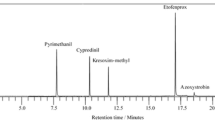Abstract
A new analytical method was developed for the simultaneous determination of seven food additives (Ponceau 4R, Allura Red AC, Amaranth, 4-hydroxymethyl benzoic acid, ethyl-4-hydroxybenzoate, butyl-4-hydroxybenzoate, and saccharin sodium) in kimchi using high-performance liquid chromatography-electrospray ionization tandem mass spectrometry. The linearity, sensitivity, selectivity, precision, and accuracy of the method were validated. The limit of detection was 0.00004–0.24 μg/mL, and the limit of quantification was 0.00012–0.8 μg/mL. Recoveries ranged from 85.65 to 120.82%. The method was successful and may help to ensure food safety.


Similar content being viewed by others
References
Cheigh HS, Park KY. Biochemical, microbiological and nutritional aspects of kimchi (Korean fermented vegetable products). Crit. Rev. Food Sci. 34: 175–203 (1994)
Hong Y, Yang HS, Li J, Han SK, Chang HC, Kim HY. Identification of lactic acid bacteria in salted Chinese cabbage by SDS-PAGE and PCR-DGGE. Sci. Food Agric. 94:296–300 (2014)
Kim J, Bang J, Beuchat LR, Kim H, Ryu JH. Controlled fermentation of kimchi using naturally occurring antimicrobial agents. Food Microbiol. 32:20–31 (2012)
Choi MW, Kim KH, Kim SH, Park KY. Inhibitory effects of kimchi extracts on carcinogen-induced cytotoxicity and transformation in C3H/10T1/2 cells. Korean Soc. Food Sci. Nutr. 2: 241–5 (1997)
Lee YM, Choi JS, Kwon MJ, Kim JK, Suh HS, Song YO. Isolation and identification of active principle in Chinese cabbage kimchi responsible for antioxidant effect. Korean J. Food Sci. Technol. 36:129–133 (2004)
Kim JY, Lee YS. The effects of Kimchi intake on lipid contents of body and mitogen response of spleen lymphocytes in rats. Korean Soc. Food Sci. Nutr. 26:1200–1207 (1997)
Sofos JN, Beuchat LR, Davidson PM, Johnson EA. Naturally occurring antimicrobials in food. Regul. Toxicol. Pharmacol. 28: 71–72 (1998)
IARC. Monographs on the Evaluation of the Carcinogenic Risk of Chemicals to Humans. IARC, Lyon. 35: 125p (1985)
Robens JF, Dill GS, Ward JM, Joiner JR, Griesemer RA, Douglas JF. Thirteen-week subchronic toxicity studies of Direct Blue 6, Direct Black 38, and Direct Brown 95 dyes. Toxicol. Appl. Pharmacol. 54:431–442 (1980)
Ibero M, Eseverri JL, Barroso C, Botey J. Dyes preservatives and salicylates in the induction of food intolerance and/or hypersensitivity in children. Allergol. Immunopathol. 10: 263–268 (1982)
Miller K. Sensitivity to tartrazine. Br. Med. J. 285: 1597–1598 (1982)
Settipane GA, Chafee FH, Postman IM, Levine MI, Saker JH, Barrick RH. Significance of tartrazine sensitivity in chronic urticaria of unknown etiology. Allergy Clin. Immunol. 57:541–546 (1976)
Combes RD, Haveland-Smith RB. A review of the genotoxicity of food, drug and cosmetic colours and other azo, triphenylmethane and xanthene dyes. Mutat. Res. Genet. Toxicol. 98: 101–243 (1982)
McCann D, Barrett A, Cooper A, Crumpler D, Dalen L, Grimshaw K, Kitchin E, Lok K, Porteous L, Prince E, Sonuga-Barke E, Warner JO. Stevenson J. Food additives and hyperactive behaviour in 3-year-old and 8/9-year old children in the community: a randomised, doubleblinded, placebocontrolled trial. LANCET 370: 1560–1567 (2007)
GSFA. Codex General Standard for food additives. Codex Stand 192- 1995 (1995)
Ministry of Health, P.R.C. Hygienic Standards for Uses of Food Additives, National Standard of the P.R.C., Beijing, 90 (2007)
Saad B, Bari MF, Saleh MI, Ahmad K, Talib MKM. Simultaneous determination of preservatives (benzoic acid, sorbic acid, methylparaben and propylparaben) in foodstuffs using high-performance liquid chromatography. Chromatogr. A. 1073: 393–397 (2005)
Mikami E, Goto T, Ohno T, Matsumoto H, Nishida M. Simultaneous analysis of dehydroacetic acid, benzoic acid, sorbic acid and salicylic acid in cosmetic products by solid-phase extraction and high-performance liquid chromatography. Pharm. Biomed. Anal. 28: 261–267 (2002)
Pan Z, Wang L, Mo W, Wang C, Hu W, Zhang J. Determination of benzoic acid in soft drinks by gas chromatography with on-line pyrolytic methylation technique. Anal. Chim. Acta. 545: 218–223 (2005)
Thompson AC, Hedin PA. Separation of organic acids by thin-layer chromatography of their 2,4-dinitrophenylhydrazide derivatives and their analytical determination. Chromatogr. A. 21:13–18 (1966)
Khan SH, Murawski MP, Sherma J. Quantitative high performance thin layer chromatographic determination of organic acid preservatives in beverages. Liq. Chromatogr. 17: 855–865 (1994)
Pant I, Trenerry VC. The determination of sorbic acid and benzoic acid in a variety of beverages and foods by micellar electrokinetic capillary chromatography. Food Chem. 53:219–226 (1995)
Nevado JJB, Robledo VR, Callado CSC. Monitoring the enrichment of virgin olive oil with natural antioxidants by using a new capillary electrophoresis method. Food Chem. 133:497–504 (2012)
Panusa A, Gagliardi L. Counterfeit homeopathic medicinal products: Syrups A simple and rapid LC–ESI-MS method to detect preservatives not declared in label. Pharm. Biomed. Anal. 47:786–789 (2008)
Kenny O, Smyth TJ, Hewage CM, Brunton NP. Antioxidant properties and quantitative UPLC-MS analysis of phenolic compounds from extracts of fenugreek (Trigonella foenum-graecum) seeds and bitter melon (Momordica charantia) fruit. Food Chem. 141:4295–4302 (2013)
Tranchida PQ, Franchina FA, Zoccali M, Pantò S, Sciarrone D, Dugo P, Mondello L. Untargeted and targeted comprehensive two-dimensional GC analysis using a novel unified high-speed triple quadrupole mass spectrometer. Chromatogr. A. 1278:153–159 (2013)
European Commission. Guidance on analytical quality control and validation procedures for pesticide residues analysis in food and feed. SANCO/12571/2013, 19 November 2013 rev. 0(2013)
Acknowledgements
We are no funding received or any financial or material support.
Author information
Authors and Affiliations
Corresponding author
Rights and permissions
About this article
Cite this article
Kim, H.J., Lee, M.J., Park, H.J. et al. Simultaneous determination of synthetic food additives in kimchi by liquid chromatography-electrospray tandem mass spectrometry. Food Sci Biotechnol 27, 877–882 (2018). https://doi.org/10.1007/s10068-018-0308-2
Received:
Revised:
Accepted:
Published:
Issue Date:
DOI: https://doi.org/10.1007/s10068-018-0308-2




